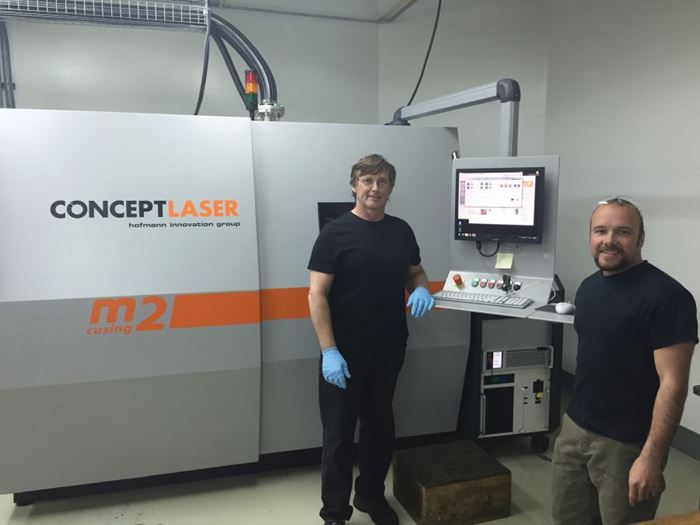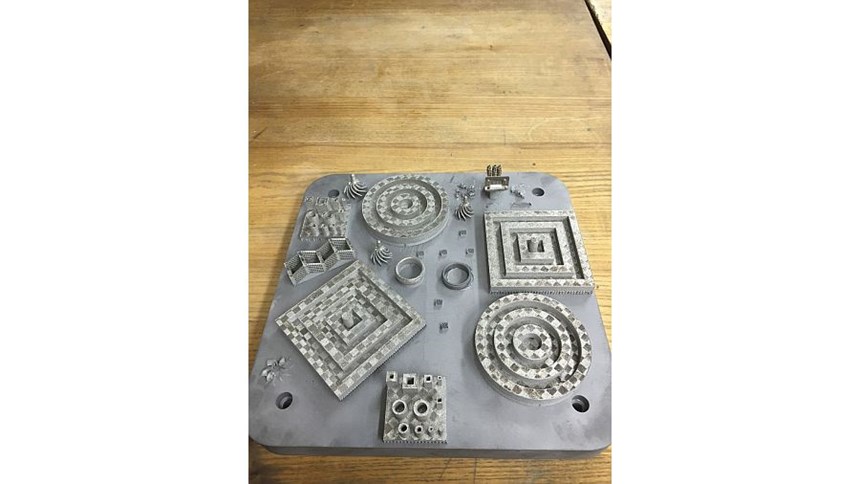A Layered Approach to Boosting Business and the Industry
Faustson Tool uses its pioneering spirit to carefully take on metals additive manufacturing one step at a time, and today the company is committed to educating and supporting industry and its academic partners with this technology.
Share
Read Next
The last time I spoke with Heidi Hostetter, Faustson was on the verge of making a significant investment in metals additive manufacturing to add more depth to her company’s current manufacturing processes. That was fall 2014. Today, after much research on the additive technologies currently on the market, Hostetter, Faustson Tool’s vice president, is excited to tell me that a new Concept Laser M2 laser melting machine is installed and running at the shop.
While many companies take a wait-and-see approach toward adopting new technology, Faustson considers itself the “iPhone of the industry,” willing to take the risks and pioneer the unknown, according to Hostetter. For example, back in the 1990s, Faustson made a decision and commitment that the shop would adopt and become proficient with five-axis machining technology.
Now, this high-precision machine shop, operating in a 16,000-square-foot facility outside of Denver, Colorado, specializes in five-axis manufacturing for the aerospace, defense, energy, medical and semiconductor industries. Faustson uses its new M2 laser melting additive manufacturing system to produce any components that the company believes might be a fit for this new and evolving technology. Its initial projects were for the biotechnology and aerospace industries, although the company says it is willing and able to work with any customers who want to learn this technology.
Seeing the machine in action was key to the final purchasing decision for Faustson. Suppliers of other technology options were unable to demonstrate their machines for the company, or seemed to show a lack of responsiveness. Hostetter is glad she noted this. “You cannot overemphasize the importance of service when it comes to these machines,” she says.
It was a trip to NASA’s Marshall Space Flight Center in Huntsville, Alabama, that sealed the deal for her. “They were equipped for the past four years with the same Concept Laser machine we were considering,” she says. “It was just a few revisions behind.” The NASA personnel, who had been involved with additive technology for 20 years at that point, assured her the machine would be a good fit. She adds, “They also offered their support and willingness to share all they’ve learned using this machine if we would educate them on our experience with five-axis machining. It was a no-brainer at that point.”
Making the Leap
According to Hostetter, getting into additive manufacturing does not require that a company adopt a new business model; it causes just a slight disruption in operations. “We thought, ‘It’s not subtractive, it’s nothing like machining, but it’s still metal. We can do this,’” she says. “We didn’t want to have a different corporate structure. We wanted to make sure the current processes and procedures in place could accommodate this innovation, and it fit seamlessly into our current business model and added value to our capabilities.”
Although the many benefits of AM are well-known—increased part strength, reduced part weight, the ability to create complicated features, no assembly required—many of the AM pioneers who have successfully realized those benefits do not share their experiences, or their formula for success. “We decided that if we get into this, we must act as a resource for others, promoting the next step in the maturation of the additive metals industry,” she says. For example, Faustson has reached agreements with customer Ball Aerospace & Technologies of Boulder, Colorado, to disclose its experiences where propriety isn’t violated. The machine shop also brought in Marshall Space Flight
Center staff members to meet with Ball Aerospace and another customer, Woodward Inc. of Fort Collins, Colorado, to relate their experiences with using the technology.
In other words, Faustson facilitates information-sharing within its corner of the manufacturing industry as much as it can. In fact, the company believes industry needs someone specifically in contract manufacturing to champion AM as a resource for making products better. Faustson does not produce its own products, it manufactures its customers’ products, so the shop pushes the technology for the benefit of its customers. Faustson aims to produce not only parts but also processes for customers, then share what it has learned
wherever it is not prohibited by non-disclosure or other agreements. Again, service is key.
Faustson also often will follow up production with a design-for-manufacturing report that indicates the atmosphere the day the machine ran, as well as recommended features for printing, part design elements that potentially need to be reconsidered, process recommendations for future builds and so on. For example, such a report might indicate that the product’s holes could benefit from being 6 mm and smaller, or that the surface finish needs to be specified in critical locations versus across the whole part. All of this information creates best practices that flow back to the design engineers, resulting in improved processes and products.
“Everyone gains from this flow of information,” Hostetter says. “The more educated people are, the more collaboratively you can work together with customers. You end up making a better product. It’s all about that.”
Opening Doors
Almost immediately after it was installed this spring, the laser melting machine opened the door to the biotechnology community for Faustson. Biotechnology is technology based on biology, using cellular and biomolecular processes to develop technologies and products designed to combat diseases, use less and cleaner energy, and have safer, cleaner and more efficient manufacturing processes.
“The bio community requires quite a bit of support equipment, tooling, fixtures and other hardware for its labs, and we hope to provide a quicker and more cost-effective means of supporting that community and its labs through our 3D printing services,” Hostetter says.
For example, one bio company Faustson is working with is a tissue donor organization. Faustson is generating support equipment for this company’s proof-of-concept project, creating hardware that will be needed to produce the end product, a device for tissue donation.
“They came to us with a problem, a part they needed for support equipment that required a lot of welding and for which they cannot wait a long time,” Hostetter explains. “We looked at the part and were able to show them ways to do things differently, which would allow us to 3D print the part, saving them 50 hours of milling time and all post-welding operations. They said, ‘Give us 10!’”
Understanding Two Fundamentals
A thorough understanding of the building material and of its post-processing requirements is crucial to producing a satisfactory product, Hostetter says. Here is part of what that understanding entails:
Material knowledge. Before making the investment in metals additive manufacturing, she says, it is important that a manufacturer know how to work with metals in the first place. Technological understanding that has made a company successful in plastics will not necessarily
naturally transfer when the company begins working with metals, because the science behind metals is completely different. Just consider the “movement” of each material. When you apply heat to plastic, it melts. When you apply heat to metal, it stabilizes its structure. The technology used does not change the need to understand basic material properties.
Hostetter recommends that manufacturers who work with metals have a good relationship with a heat treater who understands, for example, that a metal like 17-4 PH stainless steel must be heat treated to a certain specification.
Post-processing demands. Secondary processing of printed parts is as important as, or possibly more important than, the printing itself. Hostetter believes that this is Faustson’s strength in additive manufacturing. The company offers a wide variety of support equipment required for metals 3D printing, ranging from multi-axis EDMs to five-axis mills to inspection machines. “In many cases, bringing the part into specification requires all of these,” she says.
Without such support equipment capable of post-processing parts, Hostetter believes many companies new to additive manufacturing are setting themselves up to fail. She relates the story of one company that opened a location nearby and bought two top-of-the-line 3D printers. With no support equipment in place, however, the venture failed, because the company could not meet its customers’ expectations for finished parts.
Failure like this comes down to a simple lack of education, Hostetter says. In order to be successful, users must have a clear understanding of how to use AM technology effectively. “Talk to your customers and understand their needs fully before you make a major capital investment. If there is a gap there, everyone loses,” she says.
Shifting a Mindset
Although it’s been in use for only a few months, Faustson’s M2 laser melting machine has already had a tremendous impact on the mindset of the company, Hostetter says. “When we went from three- and four-axis machining to five-axis machining, we were just learning to work with another axis, and perhaps a different control system. Additive manufacturing requires a whole different mindset, because it is abstract. The sell is different, part setup is different and training is different.”
Selling the process takes much longer and is more complicated, but Hostetter believes in time this will ease. She expects the conversation to be completely different in 10 years as the visibility and knowledge surrounding the technology increases, and “everyone is doing it, everyone knows how to design for it and everyone knows how to utilize the equipment.” With knowledge comes power, but this will take time.
“With additive manufacturing, we are asking a generation of people from the machining world to think abstractly as opposed to mechanically. It is all about retraining their brains. Mechanical engineering currently is holes and squares. But additive manufacturing is ovals, 45 degrees and steeper angles. Additive allows you to make parts that you were not inclined to imagine to previously.”
Related Content
3D Printed Cutting Tool for Large Transmission Part: The Cool Parts Show Bonus
A boring tool that was once 30 kg challenged the performance of the machining center using it. The replacement tool is 11.5 kg, and more efficient as well, thanks to generative design.
Read More8 Cool Parts From RAPID+TCT 2022: The Cool Parts Show #46
AM parts for applications from automotive to aircraft to furniture, in materials including ceramic, foam, metal and copper-coated polymer.
Read MoreVelo3D Founder on the 3 Biggest Challenges of 3D Printing Metal Parts
Velo3D CEO and founder Benny Buller offers this perspective on cost, qualification and ease of development as they apply to the progress of AM adoption in the future.
Read MoreAdditive Manufacturing Production at Scale Reveals the Technology's Next Challenges: AM Radio #28
Seemingly small issues in 3D printing are becoming larger problems that need solutions as manufacturers advance into ongoing production and higher quantities with AM. Stephanie Hendrixson and Peter Zelinski discuss 6 of these challenges on AM Radio.
Read MoreRead Next
4 Ways the Education and Training Challenge Is Different for Additive Manufacturing
The advance of additive manufacturing means we need more professionals educated in AM technology.
Read MoreAt General Atomics, Do Unmanned Aerial Systems Reveal the Future of Aircraft Manufacturing?
The maker of the Predator and SkyGuardian remote aircraft can implement additive manufacturing more rapidly and widely than the makers of other types of planes. The role of 3D printing in current and future UAS components hints at how far AM can go to save cost and time in aircraft production and design.
Read MoreHybrid Additive Manufacturing Machine Tools Continue to Make Gains (Includes Video)
The hybrid machine tool is an idea that continues to advance. Two important developments of recent years expand the possibilities for this platform.
Read More

























